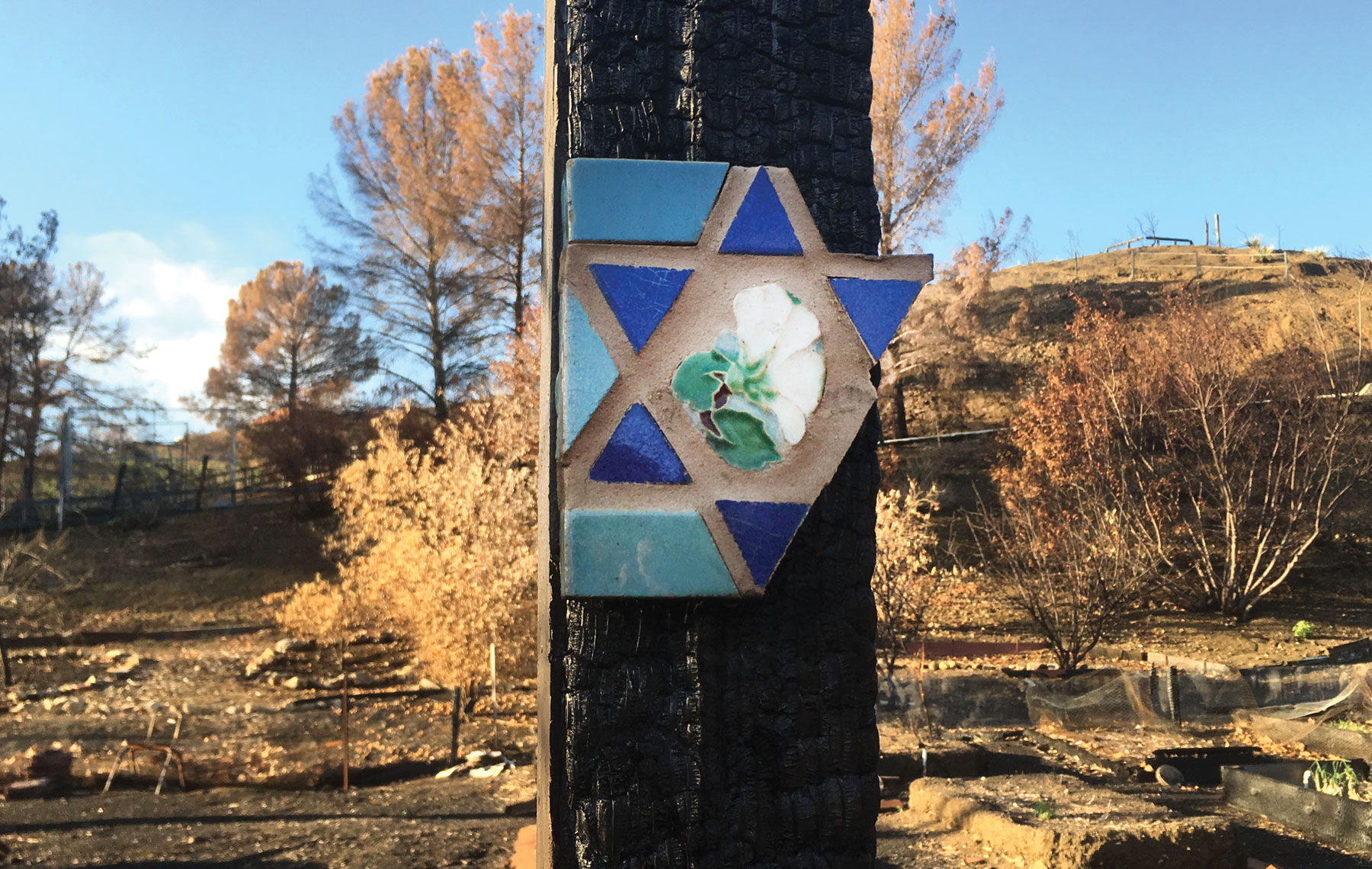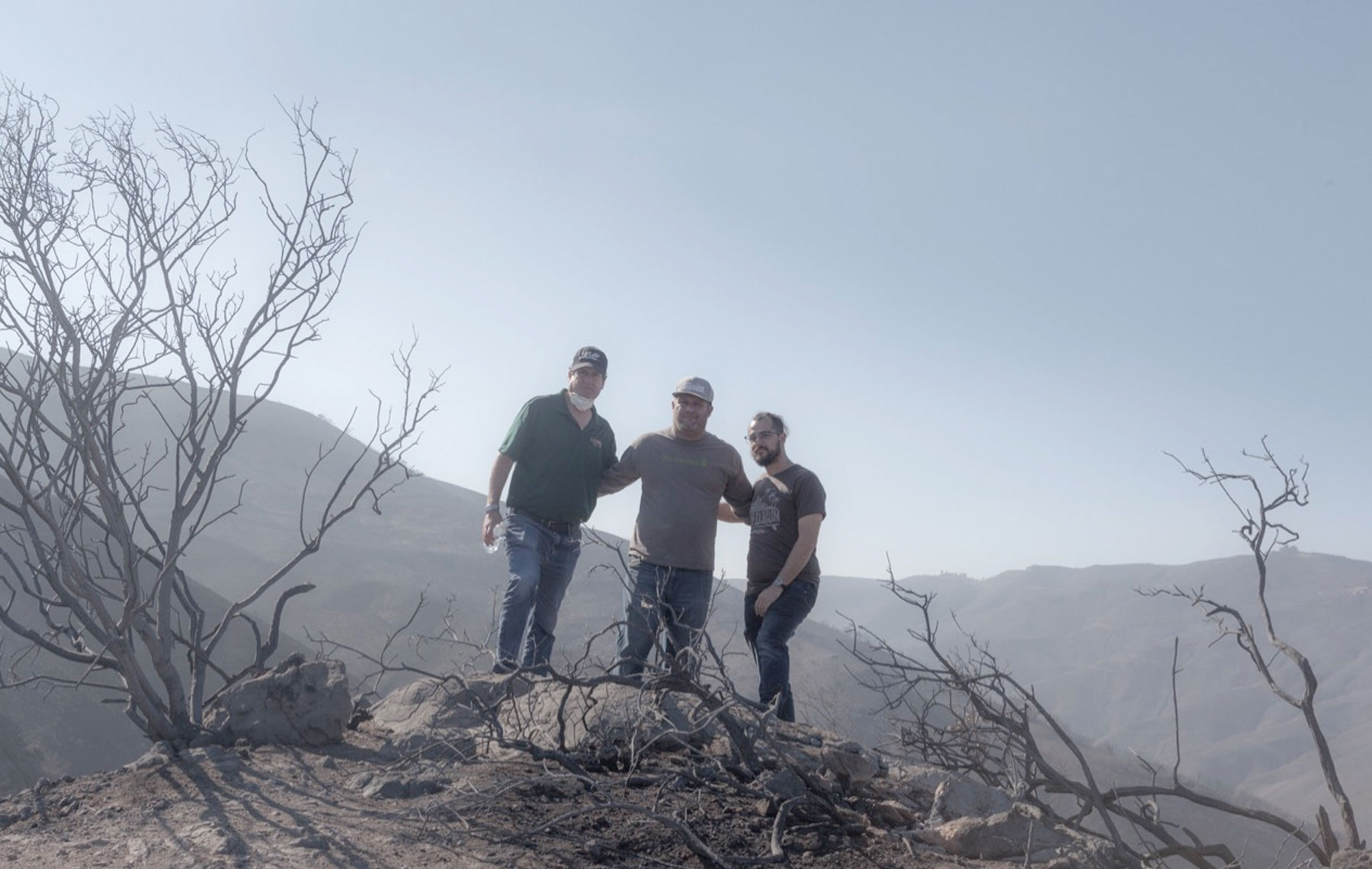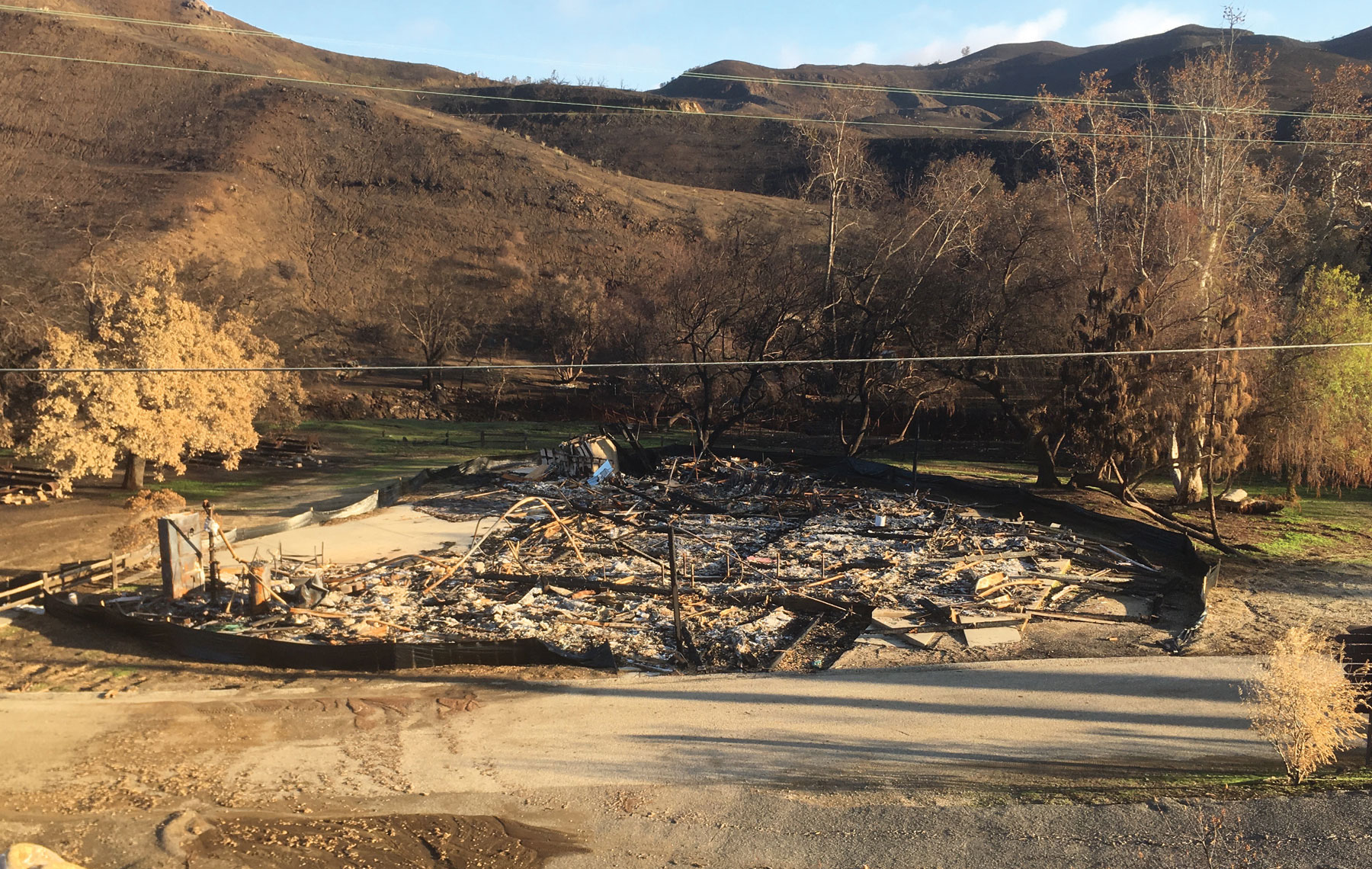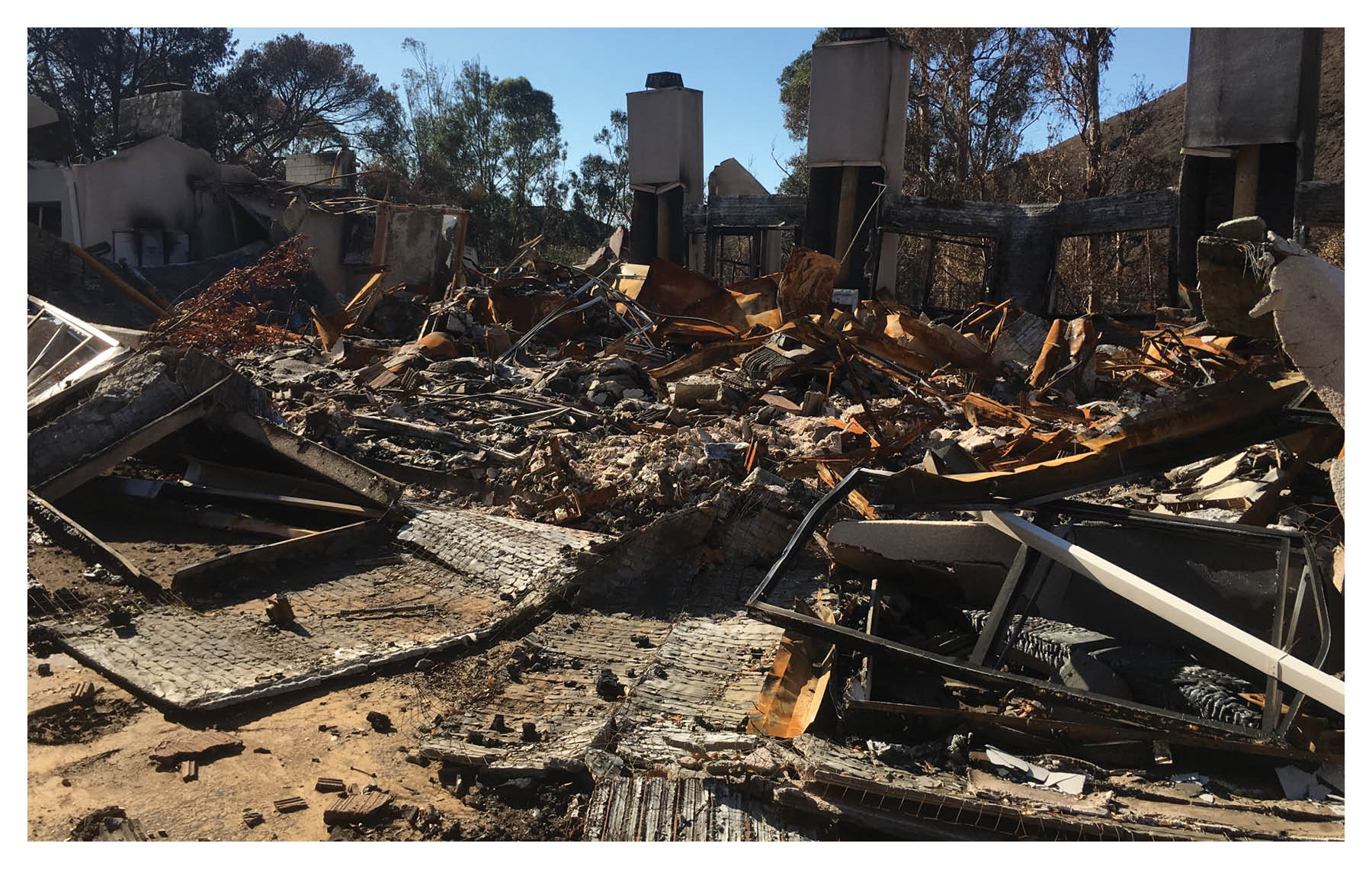 A broken Star of David at the largely destroyed Shalom Institute.
A broken Star of David at the largely destroyed Shalom Institute.
Photo by Ryan Torok
A broken Star of David at the largely destroyed Shalom Institute.
A broken Star of David at the largely destroyed Shalom Institute.
Photo by Ryan Torok
It’s just over a week before Tu B’Shevat on a sunny morning in Malibu, and Wilshire Boulevard Temple (WBT) Camps, which operates Camp Hess Kramer and Gindling Hilltop Camp, is largely deserted, save for the occasional worker driving a 4×4 pickup truck on the windy, mud-caked roads, and a cleanup crew, wearing protective yellow hazmat suits and face masks, sweeping pools of dirty rainwater off platforms surrounding the few remaining buildings.
“Welcome to the disaster zone,” says WBT Camps Executive Director Doug Lynn at the entrance to the camps.
He’s referring, of course, to the devastation wreaked by the Woolsey Fire in November, which decimated 27 of its 28 cabins on the 187-acre property.
Inside the camp stands a pickup truck, burned to a crisp and frozen in time. Nearby, a building that used to house staff during summer sessions looks like the target of a drone attack. Nails and broken shards of glass litter the ground. It’s hard to believe this was once the crown jewel of the Reform camping community in Southern California.

Lynn, 45, who has been working at the camp for 14 years, trudges through the wreckage, made worse by recent mudslides. He laughs in disbelief at the areas that were once roads, now completely buried by mud. “This looks like a field. It’s not,” he promises. “There’s a road under here, clearly defined.”
The vegetation used to serve as a protective barrier, shielding the camps from mudslides during rainstorms, but the fire destroyed all the vegetation. “In this environment, there is nothing holding the hillside up,” Lynn says.
He points to what once was the outdoor sanctuary, a place of worship, where the ark and the amud — the pillar — were destroyed; the swimming pool that now looks like a flat parcel of earth filled to the brim with mud.
Recalling seeing the camp for the first time after the fire, Lynn says, “It was surreal. It was like walking on the moon. It was white as far as the eye can see.”
The fire also destroyed the homes of nine staff members living onsite, and WBT had to find new housing for them. With the forced closure of the camp, many employees lost their jobs. WBT found them new positions at its synagogue campuses in West L.A. and Koreatown.
“It’s been a really hard process because so many of our staff have been working here for so many years, but we are really trying to live our ideals of community,” Lynn says. “The temple made a decision that we will take care of our own people.”
WBT Assistant Camps Director Ari Kaplan, 29, was 8 years old when he began attending Camp Hess Kramer. He fell in love with Kramer because, he says, it was a place he could be his “fullest self.”
“It’s in my blood,” he explains. “My dad was a camp director here. I made my closest friends here. It’s a place where you can be yourself. It’s an easy place to fall in love with.”
“You can’t tell now,” Lynn adds wistfully, “but it was beautiful.”
He says that although many people have expressed a desire to help WBT rebuild, the camp does not yet know how much money it will need to raise.
“We spent some time being sad. Camp has been around for 70 years and it was wonderful,” Lynn says. “This is an opportunity to look at what camp will be for the next 70 years. That’s the uplifting part of it. It will take fundraising and committed people already stepping up saying, ‘I want to be involved.’”

Photo by Ryan Torok
The organization currently is looking for a temporary site for its upcoming summer camps. It is working with the California Coastal Commission in the debris-removal process and has applied to the Federal Emergency Management Agency for financial assistance.
While Lynn says it’s too early to talk about Tu B’Shevat — the birth of trees — in connection with the camp, Rabbi Bill Kaplan, executive director of the Shalom Institute in Malibu, is eager to draw parallels.
The Institute, which hosted Camp JCA Shalom at its 220-acre property, was also devastated by the Woolsey fire. It lost 35 of its structures. Twenty-nine staff members living onsite with their families had to find new homes, and much of the Institute’s vegetation and trees were destroyed in the blaze.
Looking over the remains of the camp, which is still closed, Kaplan says they’ll be marking the holiday as the “re-birthday of the trees. The trees are coming back and the trees are alive,” he says. “They’re still here and they are the core of what the Shalom Institute is about.”
In previous years, the Institute has held Tu B’Shevat community events but this year, the fire made that impossible. However, on Jan. 20, spiritual community Nashuva will gather at TreePeople to prepare native plants and trees to plant at fire and drought-damaged areas in the Santa Monica mountains. TreePeople Founder and President Andy Lipkis plans bring the plants to the Shalom Institute’s home in Malibu.
“If you think about it, this is the very intent and meaning behind the holiday of Tu B’Shevat,” Lipkis said in an email. “Teaching and reminding people about caring for and protecting our trees and forests, so we can all survive and thrive.” (Q-and-A with Lipkis, page 54).
And on Jan. 22, the Institute will lead students from Abraham Joshua Heschel Day School in an offsite day of Tu B’Shevat activities.
Kaplan calls himself the “King of Tu B’Shevat,” and combines his love of Judaism with his passion for the outdoors in the belief that Jews are not just the “People of the Book” but also the “People of the Land.”
In addition to his responsibilities at the Shalom Institute, Kaplan runs an educational program called Edible Judaism, which offers a “pathway and opportunity to Jewish education” through an appreciation of nature.

Photo by Ryan Torok
And while Kaplan mourns the loss of the Marla Bennett Israel Discovery Center and Garden in the fire (named in honor of a Camp JCA Shalom alumnus killed in a terror attack in Israel in 2002), he praises the successful relocation of the Institute’s Shemesh Farms, the home of 20 varieties of bulk herbs, vegetables, native flowers and fruit trees. The site employed 45 adults with special needs who tended to the land and crafted products that were then sold to support Shemesh Enterprises.
The Malibu Jewish Center and Synagogue was untouched by the fire and has taken on Shemesh Farms. The Institute plans to build raised flower beds and use a vertical growing system called a “tower garden” in the hopes of building an even bigger farm on the synagogue’s available acreage.
Because of its proximity to the Pacific Ocean, Kaplan has taken to describing the farm as “Shemesh by the Sea,” and touting it as an example of turning “adversity into opportunity.”
The Institute already has secured a temporary site for this summer. It will hold Camp JCA Shalom at the Gold Creek Center in the Angeles National Forest. The site is the former home of legendary filmmaker Cecil B. DeMille and is owned by the Korean Presbyterian Church. The Institute will rent the space from May through September in 2019 and 2020.
“It’s an incredible facility on its own mountain,” Kaplan says. “For the next couple of years, we’re on the road.”
For now, Kaplan is thankful for the small things, encouraged by the signs of life springing up around the camp. Fresh green has grown on charcoaled hills, new growth has sprung on the oak trees, and the organization’s arborist says the majority of the plant life will grow back.
“Our theme is from ashes to blossoms, and you can see now this new growth going all along the tree up here,” Kaplan says, pointing to one of the oak trees. “You look over here, you can see an incredible amount of new growth. For us, that is inspiring.”























 More news and opinions than at a Shabbat dinner, right in your inbox.
More news and opinions than at a Shabbat dinner, right in your inbox.